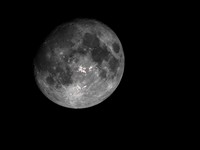 A talent for finding value in rock has never been in short supply in Sudbury, but this instance is lunacy. Literally.
A talent for finding value in rock has never been in short supply in Sudbury, but this instance is lunacy. Literally.
A pacesetter in the development of mining technology for space exploration, the Northern Centre for Advanced Technology (NORCAT) is peddling simulated moon dirt for $40,000 a tonne.The Canadian Space Agency has already put in an order for one tonne of the stuff and orders have materialized from as far away as Poland. According to NORCAT director of innovation Dale Boucher, NASA predicts it will need 100 tonnes of the material within the next five years.
It turns out that moondust – better known as lunar regolith in the space industry – is nothing like dirt here on Earth.
“It’s nasty material,” said Boucher. “It’s extremely abrasive, very clinging, and it’s very fine, so it will invade joints and destroy bearings.”
NORCAT had an interest in developing a material to simulate lunar regolith because the mining equipment it is developing under contract with the Canadian Space Agency will have to contend with it.
Beach sand particles on Earth are round, said Boucher. “If you take beach sand and dry it out, it flows. Lunar material is never round. It has odd shapes. It has hooks. These shapes cause the material to compact.
“You can take Apollo 16 material, pour it into a pile, undecut it and it will support itself without any compaction. You can do it with our simulant as well.”
NORCAT and its Sudbury partner, Electric Vehicle Controllers, came to the conclusion three years ago that there was nothing available that could replicate the mechanical and geotechnical characteristics of lunar soil. The Sudbury innovation centre enlisted Melissa Battler of the University of New Brunswick’s Planetary and Space Science Centre to assist in developing a simulant, and a deposit able to serve as the raw material for the stuff was discovered northwest of Timmins.
“We reached an agreement with the owner of the deposit to mine the material,” he said. “We did pilot-level production runs and now have 100 tonnes of the material available. It’s a combination of appropriate feed material and processing. There are a number of stages in the process.” For one part of the process, the material is sent to Denver, Colorado.
NORCAT drills and rovers destined for the moon must be designed to prevent the ingress of the fine, abrasive particles. Equally important is the need to design excavator blades, buckets and hoppers that take into account the material’s natural tendency to hang up.
Chenobi lunar highlands physical simulant, as it’s branded, is sold in five-gallon pails containing 20 kilograms of dirt. One pail goes for $880 a pop. Inquiries can be made by emailing

